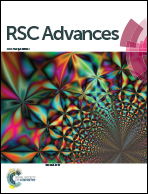Synthesis of ferrocene-based saccharides and their anti-migration and burning rate catalytic properties†
Abstract
In the search for ferrocene-based burning rate catalysts (BRCs) with good burning rate catalytic properties and low migration, we synthesized four ferrocene-based saccharides (S-Fcs). The synthesis of S-Fcs was confirmed by energy-dispersive X-ray (EDX), nuclear magnetic resonance (1H NMR), Fourier transform infra-red (FT-IR) and ultraviolet-visible (UV-Vis) spectroscopy. The electrochemical behavior of ferrocene-based BRCs is important to investigate the electron transfer burning rate catalytic mechanism. Therefore, the electrochemical behavior of the S-Fcs was investigated by cyclic voltammetry. The burning rate catalytic properties of the S-Fcs on thermal disintegration of ammonium perchlorate (AP) were determined by TG and DTG techniques. Thermal analysis results showed that the S-Fcs were thermally stable and showed good burning rate catalytic effects on thermal disintegration of AP. The S-Fcs were also analyzed in anti-migration studies in comparison with the most commonly used ferrocene-based burning rate catalyst (catocene) and ferrocene. It was found that S-Fcs showed excellent anti-migration behavior in AP-based propellant as compared to catocene and ferrocene.


 Please wait while we load your content...
Please wait while we load your content...